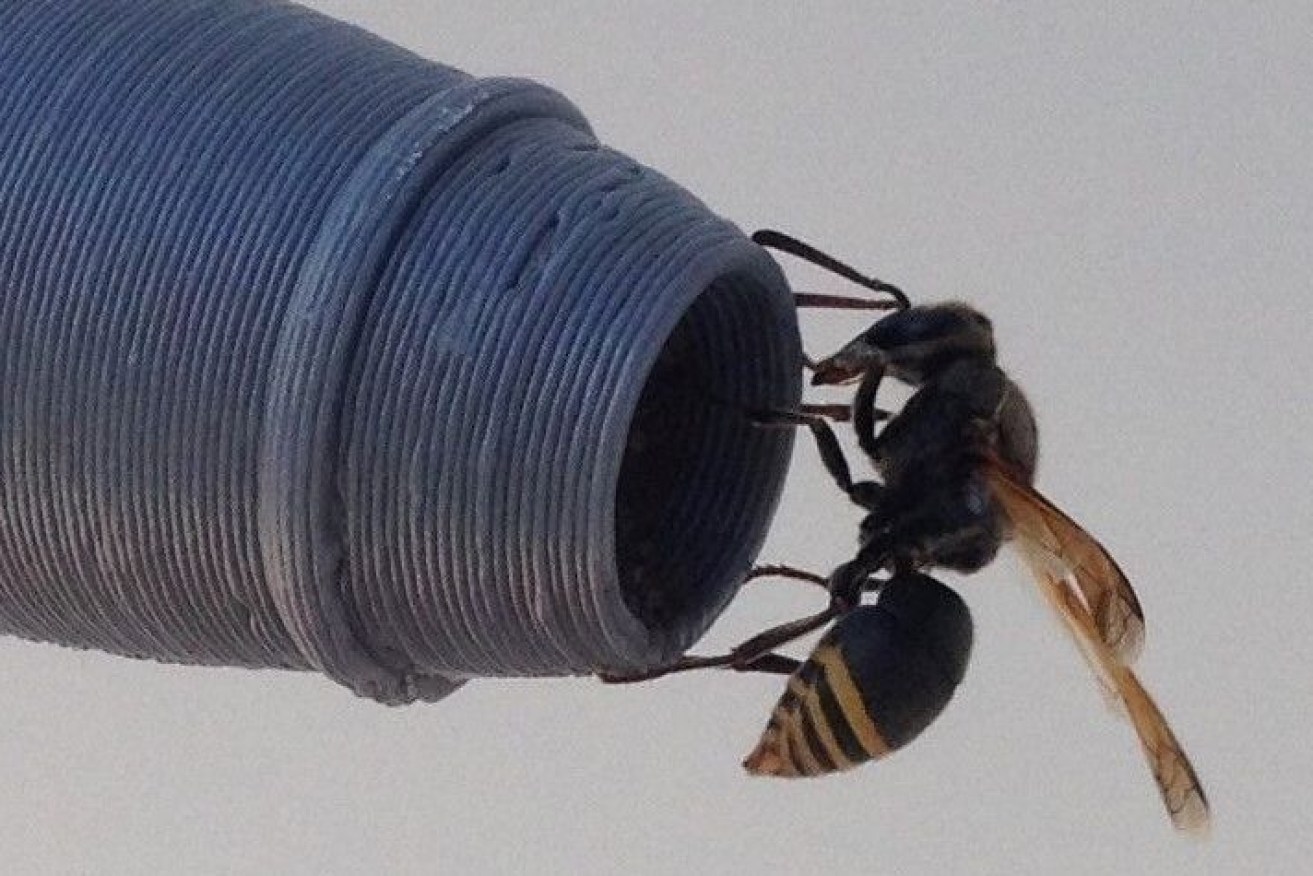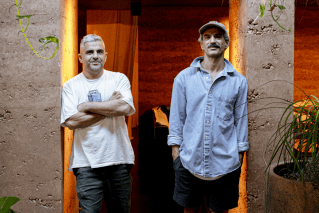How this tiny wasp could pose a deadly threat to Queensland air travellers
It’s less than a centimetre long and you’d probably shoo it away without a second thought, but the keyhole wasp may pose a “significant risk” to passenger aircraft safety, research finds.

A female keyhole wasp, checking out a replica pitot probe to see if it's a suitable nest site.(Supplied: House Et Al (2020) PLOS One)
The study, published in the journal PLOS One today, came off the back of a series of incidents at Brisbane Airport where wasp nests, constructed in an aircraft’s speedometer, forced planes to abandon take-off or even turn back after departure.
A few types of nesting wasps live in the Brisbane area, but no-one knew which was responsible for cutting flights short.
The culprit — a small black wasp with yellow bands on its pointed abdomen nicknamed the keyhole wasp (Pachodynerus nasidens) — is a recent arrival to our shores.
Native to the Caribbean and South and Central America, it was discovered in Australia during a routine quarantine check at the Port of Brisbane in 2010, and first spotted at Brisbane Airport two years later.
It can nest in plants and in the ground, but it’s named for its propensity to take advantage of artificial nooks and crannies — such as keyholes — when it builds nests.
And they can be a massive headache when they get into things like vital aircraft instruments.
The instruments in question are called pitot probes. These thin tubes calculate airspeed by measuring the difference in pressure between air flowing into the tube through its central hole, and air entering holes drilled in the probe’s side.
Large aircraft use multiple pitot probes. You can often see them jutting out beneath the cockpit or on the wings.
If they all show the same readings, that’s great — the pilot is certain of their speed. Any discrepancies, though, and the pilot can’t be sure of how fast they’re travelling.
This is particularly important during the most dangerous parts of air travel: take-off and landing.
In the first three months of 2006 alone, five flights departing Brisbane had pitot probes that gave inconsistent airspeed readings.
Those flights either pulled out of take-off while the plane was still on the tarmac, or flew to their destination anyway, but with a malfunctioning pitot probe.
All five were Airbus A330s.
Then in 2013, another A330 made an emergency landing at Brisbane Airport shortly after take-off.
Upon inspection, the Australian Transport Safety Bureau found a wasp nest, constructed in less than two hours that had “almost totally obstructed” a pitot probe.
Incidents like these prompted Alan House and his colleagues from Brisbane Airport and consultancy firm Ecosure to find out what species of wasp was behind the blocked probes and if they favoured certain aircraft.
The team attached 3D-printed replica pitot probes to panels and put them up around domestic and international terminals at Brisbane airport between February 2016 and April 2019.
They regularly checked each probe, and when they found one was blocked, they removed it and hatched any eggs inside to identify the species.
The species that emerged, time and again, was the keyhole wasp.
“These wasps are not the only ones to do this, but they seem to be particularly adept,” Dr House, now principal ecologist at consultancy Eco Logical Australia, said.
Maintenance crews have reported seeing a wasp fly around the nose of a plane within a minute of it arriving — a phenomenon Dr House has also witnessed.
“When the plane first comes in, those probes are too hot for the wasp, so I think what she’s doing is waiting for it to cool down,” he said.
Once the probe is cool enough, the wasp crawls inside and inspects it. If she deems it a suitable nesting site, she flies off and finds food, perhaps a caterpillar, paralyses it with her sting, then flies it back to the probe, where she stuffs it inside.
Then she lays an egg next to it before building a thin wall out of mud to seal everything inside.
Eventually the egg hatches, and the wasp larva feasts on the helpless grub.
Keyhole wasps are incredibly quick nest-builders. In August 2015, an A320 flight from Brisbane to Newcastle was found to have a temperature probe blocked by a wasp nest.
It had only spent 30 minutes on the ground at Brisbane.
Keyhole wasps weren’t the only wasps that hatched from the replica tubes.
One tube yielded five adult Chrysis lincea, a shimmering blue-green species that belongs to a group dubbed cuckoo wasps, said University of Adelaide wasp taxonomist Erinn Fagan-Jeffries, who was not involved with the study.
“Rather than building their own nest, they will find an existing nest, like a keyhole wasp nest or a native bee nest,” Dr Fagan-Jeffries said.
“They open the little chamber where the host wasp larva is and lay their own egg inside.
“And then when the cuckoo wasp larva hatches out, it’ll either eat the host’s provisions — the food that the mama left for her baby — or it might even eat the larva that’s in there.”
The fact that cuckoo wasps were found in pitot tubes is “a real positive”, she added, “because it means that some native Australian parasitic wasps are able to attack this introduced species”.
So while our native wasps aren’t necessarily helping the probe-blockage issue, “there’s a chance that those native parasitoids might be able to help keep the invasive wasp populations low and stop them from spreading too fast”.
House suspects pitot probes will eventually be superseded by some other accurate airspeed-measuring technology.
Until then though, the wasp problem remains — not just in Brisbane, but potentially around Australia.
Wasps preferred nesting in warmer months, so could spread to tropical areas, and even cooler places down the track as the climate warms.
The team also found keyhole wasps liked nesting in pilot probes with larger openings, around 5 to 7 mm wide, perhaps to give the female wasp enough room to manoeuvre inside.
These are the kinds of probes found on A330s and Boeing 737s.
So should all planes swap chunkier pitot probes for more slender versions?
That would help, House said, but the problem is the cost. Pitot probes are expensive, running in the thousands of dollars each, and replacing a fleet’s probes would be immense.
Not all airlines cover their pitot probes when they land, so airports, especially those in tropical and sub-tropical regions, could make pitot probe covers mandatory on all arriving flights — but the crew must remember to take them off too.
Eliminating the wasps would be preferable, House said, but that doesn’t mean they won’t be reintroduced sometime in the future.
What do seem to work are traps. Not ones that use bait, but fake nesting sites.
Cylinders containing loads of wasp-nest-sized cavities are set up around Brisbane airport. Once a cavity is blocked by a nest, it’s replaced with an empty one, and the nest and its contents are destroyed.
“And we do have some evidence that that has already had an impact on the activity of wasps around the pitot probes,” House said.
“By reducing the total population, the breeding success goes down, especially in founder populations of invasive species like this, where the genetic base may be quite narrow to start with.”
In other words, by taking individuals — especially females — out of a population with already limited genetic variation, offspring are more likely to be inbred, and are less likely to survive and reproduce.
As air travel slowly rebounds from the COVID-19 pandemic, you shouldn’t let the threat of keyhole wasps stop you from flying out of Brisbane or any other airport, House said.
Air travel is still safer than driving a car, he added, and wasps are just one of many risks on airlines’ radars.
Indeed, he and colleagues published a risk analysis of wasp-blocked pitot probes in Transportation Research Interdisciplinary Perspectives in March this year.
“With the probe cover policies that more airlines are putting in place, and the other work the airport is doing in setting out intercept traps to reduce the number of wasps around, they have already seemed to have made a difference,” House said.
But now, he warns, airports should be extra vigilant of the keyhole wasp and its speedy nest-building mastery.
“With COVID and the partial shutdown of airports, I can guarantee that the wasp has been merrily breeding away and increasing its population, waiting for planes to start moving again.”
– ABC / science reporter Belinda Smith












